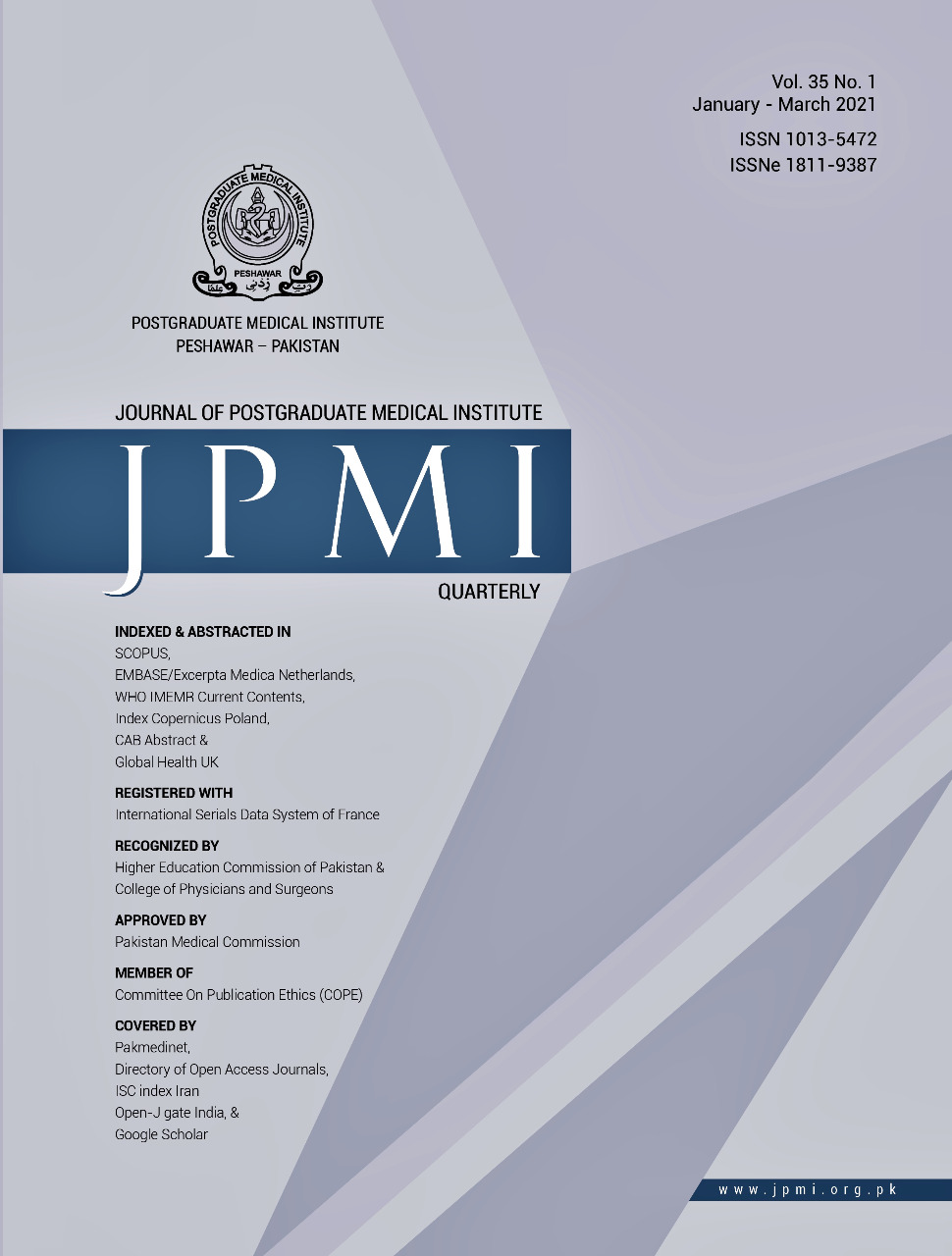CONGENITAL HEART DISEASES IN INFANTS PRESENTING WITH RESPIRATORY DISTRESS TO A TERTIARY CARE HOSPITAL
Main Article Content
Abstract
Objective: To determine the frequency of congenital heart diseases (CHD) in infants admitted with respiratory distress to pediatrics unit.
Methodology: This cross-sectional study was conducted on 261 infants, presenting with respiratory distress and treated as indoor patients in the pediatrics department, Lady Reading Hospital, Peshawar. Non probability purposibe sampling technique was used to enroll the sample. History was taken and infants were examined by a consultant pediatrician. The findings were recorded on a pre-designed proforma. Trans-thoracic echocardiography was performed at the cardiology unit of the same hosptial. SPSS v. 20.0 was used as a statistical tool.
Results: Out of 261 infants, 5 (1.9%) were found to have congenital heart disease with a mean age of 6.0±4.6 months. Female predominance was noted (n=143, 54.8%). Maternal age was 30.0±10.5 years. Pulmonary stenosis was the most CHD, reported in 2 (0.7%) patients, followed by ventricular septal defect, atrial septal defect and tetralogy of fallot, reported in 1 (0.4%) patient each.
Conclusion: The study reported a low incidence of CHD among infants with respiratory distress and may come to attention as standalone respiratory distress in infants.
Article Details
Work published in JPMI is licensed under a
Creative Commons Attribution-NonCommercial 2.0 Generic License.
Authors are permitted and encouraged to post their work online (e.g., in institutional repositories or on their website) prior to and during the submission process, as it can lead to productive exchanges, as well as earlier and greater citation of published work.
References
Mari MA, Cascudo MM, Alchieri JC. Congenital heart disease and impacts on child Development. Braz J Cardiovasc
Surg. 2016;31(3):31-7. https://doi.org/10.5935/1678-9741.20160001.
Mulder BJM. Epidemiology of adult congenital heart disease: demographic variations worldwide. Neth Heart
J. 2012;20(12):505-8. https://doi.org/10.1007/s12471-012-0335-1.
Saxena A, Mehta A, Sharma M, Salhan S, Kalaivani M, Ramakrishnan S, et al. Birth prevalence of congenital heart
disease: A cross-sectional observational study from North India. Ann Pediatr Cardiol. 2016;9(3):205-9. https://doi.org/10.1007/s12471-012-0335-1.
Kabbani N, Kabbani MS, Al Taweel H. Cardiac emergencies in neonates and young infants. Avicenna J Med. 2017;7(3):1-
https://doi.org/10.4103/2231-0770.197506.
Hussain S, Sabir MD, Afzal M, Asghar I. Incidence of congenital heart disease among neonates in a neonatal unit of a
tertiary care hospital. J Pak Med Assoc. 2014; 64(2):175-8.
Yang XY, Li XF, Lü XD, Liu YL. Incidence of congenital heart disease in Beijing, China. Chin Med J (Engl). 2009;122(10):1128-
https://doi.org/10.1007/s00246-014-0884-8.
Egbe A, Uppu S, Stroustrup A, Lee S, Ho D, Srivastava S. Incidences and sociodemographics of specific congenital heart diseases in the United States of America: An evaluation of hospital discharge diagnoses. Pediatr Cardiol. 2014;35(6):975- 82. https://doi.org/10.1007/s00246-014-0884-8.
Fatema NN CR, Chowdhury L. Incidence of congenital heart disease among hospital live birth in a tertiary hospital of
Bangladesh. Cardiovas J. 2008;1(1):14-20. https://doi.org/10.3329/cardio.v1i1.8199.
Van der Linde D, Konings EE, Slager MA, Witsenburg M, Helbing WA, Takkenberg JJ, et al. Birth prevalence of congenital
heart disease worldwide: a systematic review and meta-analysis. J Am Coll Cardiol. 2011;58(21):2241-7. https://doi.org/10.1016/j.jacc.2011.08.025.
Reuter S, Moser C, Baack M. Respiratory distress in the newborn. Pediatr Rev. 2014;35(10):417-29. https://doi.org/10.1542/pir.35-10-417.
Hermansen CL, Mahajan A. Newborn respiratory distress. Am Fam Physician. 2015;92(11):994-1002. https://doi.org/10.3126/jnps.v37i2.17623
Chapagain R, Shrestha N, Kayastha M, Shakya S, Adhikari K, Shrestha S. Spectrum of congenital heart disease in neonates
admitted in an intermediate care unit of a tertiary level hospital. J Nepal Pediatr Society. 2018;37(2):174-7. https://doi.org/10.3126/jnps.v37i2.17623.
Pate N, Jawed S, Nigar N, Junaid F, Wadood AA, Abdullah F. Frequency and pattern of congenital heart defects in a tertiary care cardiac hospital of Karachi. Pak J Med Sci. 2016;32(1):79-84. https://doi.org/10.12669/pjms.321.9029.
Mohammad N, Shaikh S, Memon S, Das H. Spectrum of heart disease in children under 5 years of age at Liaquat University Hospital, Hyderabad, Pakistan. Indian Heart J. 2014;66(1):145-9. https://doi.org/10.1016/j.ihj.2013.12.041.
Arain N, Moller J, Pyles L, Sivanandam S. “Vanishing” pulmonary valve stenosis. Ann Pediatr Cardiol. 2012;5(1):47-50. http://doi.org/10.4103/0974-2069.93711.
Sweet LR, Keech C, Klein NP, Marshall HS, Tagbo BN, Quine D, et al. Respiratory distress in the neonate: Case definition
& guidelines for data collection, analysis, and presentation of maternal immunization safety data. Vaccine. 2017;35(48):6506-17. https://doi.org/10.1016/j.vaccine.2017.01.046.
Dice JE, Bhatia J. Patent ductus arteriosus: an overview. J Pediatr Pharmacol Ther. 2007;12(3):138-46. https://doi.org/10.5863/1551-6776-12.3.138.


